Warschauer, M. (2001). On-line communication. In R. Carter & D ...
Warschauer, M. (2001). On-line communication. In R. Carter & D ...
Warschauer, M. (2001). On-line communication. In R. Carter & D ...
Create successful ePaper yourself
Turn your PDF publications into a flip-book with our unique Google optimized e-Paper software.
An edited version of this paper appeared as:<br />
<strong>Warschauer</strong>, M. (<strong>2001</strong>). <strong>On</strong>-<strong>line</strong> <strong>communication</strong>. <strong>In</strong> R. <strong>Carter</strong> & D.<br />
Nunan (Eds.), The Cambridge guide to teaching English to speakers of<br />
other languages (pp. 207-212). Cambridge: Cambridge University<br />
Press.<br />
<strong>In</strong>troduction<br />
<strong>On</strong>-<strong>line</strong> Communication<br />
by Mark <strong>Warschauer</strong><br />
The term "on<strong>line</strong> <strong>communication</strong>" refers to reading, writing, and<br />
<strong>communication</strong> via networked computers. It encompasses synchronous computermediated<br />
<strong>communication</strong> (whereby people communicate in real time via chat or<br />
discussion software, with all participants at their computers at the same time);<br />
asynchronous computer-mediated <strong>communication</strong> (whereby people communicate in a<br />
delayed fashion by computer, using programs such as e-mail); and the reading and<br />
writing of on<strong>line</strong> documents via the World Wide Web. Second language researchers<br />
are interested in two overlapping issues related to on<strong>line</strong> <strong>communication</strong>: (1) how do<br />
the processes which occur in on<strong>line</strong> <strong>communication</strong> assist language learning in a<br />
general sense (i.e., on<strong>line</strong> <strong>communication</strong> for language learning); and (2) what kinds<br />
of language learning need to occur so that people can communicate effectively in the<br />
on<strong>line</strong> realm (i.e., language learning for on<strong>line</strong> <strong>communication</strong>).<br />
Background<br />
<strong>On</strong><strong>line</strong> <strong>communication</strong> dates back to late 1960s, when U.S. researchers first<br />
developed protocols that allowed the sending and receiving of messages via computer<br />
(Hafner & Lyon, 1996). The ARPANET, launched in 1969 by a handful of research<br />
scientists, eventually evolved into the <strong>In</strong>ternet, bringing together some 200 million<br />
people around the world at the turn of the millennium.<br />
1
<strong>On</strong><strong>line</strong> <strong>communication</strong> first became possible in educational realms in the<br />
1980s, following the development and spread of personal computers. The<br />
background on on<strong>line</strong> <strong>communication</strong> in language teaching and research can be<br />
divided into two distinct periods, marked by the introduction of computer-mediated<br />
<strong>communication</strong> in education in the mid-1980s and the emergence of the World Wide<br />
Web in the mid-1990s.<br />
Computer-Mediated Communication<br />
<strong>In</strong> the first period, dating from the mid-1980s, language educators began to<br />
discover the potential of computer-mediated <strong>communication</strong> for language teaching<br />
(Cummins, 1986). The integration of computer-mediated <strong>communication</strong> in the<br />
classroom itself divided into two paths: on the one hand, some educators began to use<br />
e-mail to set up long-distance exchanges, and, on the other hand, other educators<br />
began to use synchronous software programs (in particular, Daedalus <strong>In</strong>terchange<br />
(Daedalus <strong>In</strong>c., 1989) to allow computer-assisted conversation in a single classroom.<br />
Long-distance exchanges and computer-assisted conversation had<br />
overlapping, but distinctive, justifications. Both types of activities were seen to shift<br />
the focus from language form to language use in meaningful context (e.g., Kelm,<br />
1992; Meskill & Krassimira, 2000) and thereby increase student motivation (e.g.,<br />
Meunier, 1998; <strong>Warschauer</strong>, 1996b). <strong>In</strong> addition, long-distance exchanges were<br />
viewed as brining about increased cultural knowledge from <strong>communication</strong> with<br />
native-speaking informants (e.g., Kern, 1995a; Soh & Soon, 1991), and making<br />
reading and writing more authentic and collaborative (e.g., Tella, 1992b). Those<br />
implementing computer-assisted conversation emphasized the linguistic benefits<br />
which could be achieved from rapid written interaction, such as better opportunities to<br />
2
process and try out new lexical or syntactic patterns as compared to oral interaction<br />
(e.g., Ortega, 1997; <strong>Warschauer</strong>, 1999).<br />
The World Wide Web<br />
The World Wide Web is an international on<strong>line</strong> database that allows the<br />
sharing of linked multimedia documents. These documents can be authored in a non<strong>line</strong>ar,<br />
layered and linked format, which is referred to as hypertext or hypermedia.<br />
The development and spread of the World Wide Web in the 1990s marked a second<br />
period in the use of on<strong>line</strong> <strong>communication</strong> in language teaching. <strong>On</strong>e the one hand,<br />
the Web allows additional modes of computer-mediated <strong>communication</strong> through<br />
Web-based chat rooms, bulletin boards, and discussion forums, thus making even<br />
more popular the kind of long-distance exchanges and computer-assisted conversation<br />
activities described above. <strong>In</strong> addition, the World Wide Web adds a new dimension<br />
to on<strong>line</strong> <strong>communication</strong> and learning by allowing students to find and read on<strong>line</strong><br />
documents on a variety of topics from throughout the world and to author and publish<br />
similar documents to share with others.<br />
Some researchers have viewed the Web as an extension of an L2 culture or<br />
society; by engaging in Web-based activities, students can gradually become<br />
members of the community of English language speakers, in the same way that they<br />
might through other forms of immersion in a culture (Zhao, 1996). Others view the<br />
Web as an extension of a CD-ROM, in other words, a good environment to create<br />
multimedia language learning materials with the added advantage of allowing student<br />
interactivity (Chun & Plass, 2000). Others view the Web as an extension of (and<br />
alternative to) print, that is, a major new medium of literacy that needs to be mastered<br />
on its own terms for success in 21st century life (Shetzer & <strong>Warschauer</strong>, 2000;<br />
<strong>Warschauer</strong>, 1999). Since the Web is a vast and diverse environment, encompassing<br />
3
a huge variety of on<strong>line</strong> documents and an array of evolving <strong>communication</strong>s tools, it<br />
is perhaps overreaching to seek a single unitary framework to motivate its integration<br />
in the classroom.<br />
Research<br />
Research on on<strong>line</strong> <strong>communication</strong> and second language learning has focused<br />
on three general topic areas: (1) interaction, (2) reading and writing, and (3) affect.<br />
<strong>In</strong>teraction<br />
Computer-mediated <strong>communication</strong>, which allows the recording of all<br />
messages for post hoc analysis, provides a wealth of easily accessible data for<br />
language researchers studying interaction. Studies of L2 computer-mediated<br />
interaction have thus far looked at the linguistic characteristics of computer-mediated<br />
messages, the types of negotiation and linguistic modification that occur, and the<br />
patterns of participation that emerge.<br />
Linguistic characteristics. An important question facing both L1 and L2<br />
researchers is whether computer-mediated <strong>communication</strong> has its own distinctive<br />
linguistic features. L2 research has found that computer-assisted conversation is<br />
syntactically more complex and lexically more dense than face-to-face conversation<br />
(<strong>Warschauer</strong>, 1996a). <strong>In</strong> a comparative study of two modes of student-teacher<br />
dialogue, it has also been shown that L2 students' writing via e-mail is more informal<br />
and conversational than their writings via pencil-and-paper (Wang, 1993). These<br />
studies support prior claims that computer-mediated <strong>communication</strong> tends to fall in<br />
the middle of the continuum of more formal <strong>communication</strong> (as often featured in<br />
writing) and informal <strong>communication</strong> (as often featured in speech). The studies<br />
suggest that computer-mediated <strong>communication</strong> can help serve as a useful bridge<br />
4
etween speaking and writing by facilitating L2 interaction that is linguistically<br />
complex yet informal and communicative.<br />
Negotiation and Modification. <strong>On</strong>e of the most important domains of second<br />
language research is that of negotiation and modification, that is how second language<br />
learners modify their <strong>communication</strong> in negotiation and interaction with others (see<br />
Pica, 1994). Several studies have shown extensive incorporation of new syntactical<br />
patterns or lexical chunks during computer-mediated interaction and have concluded<br />
that the on<strong>line</strong> medium facilitates such incorporation by allowing greater opportunity<br />
to study incoming messages and to carefully plan responses (e.g., Pelletieri, 2000; St.<br />
John & Cash, 1995). Research has also indicated that the types of tasks and topics<br />
chosen have an important affect on the nature of computer-mediated negotiation, with<br />
substantial benefits found from conversational tasks which are goal-oriented and<br />
which encourage learners to reflect on their own use of language (Lamy &<br />
Goodfellow, 1999; Pelletieri, 2000).<br />
Participation. L1 research has shown that computer-mediated <strong>communication</strong><br />
tends to feature more balanced participation than face-to-face conversation, with less<br />
dominance by outspoken individuals (see summary of research in Sproull & Kiesler,<br />
1991). Studies of L2 classroom discourse have validated this finding. First, it has<br />
been shown that student participation vis-à-vis teacher participation increases<br />
dramatically in computer-mediated <strong>communication</strong> (e.g., Kern, 1995b; <strong>Warschauer</strong>,<br />
1999). Second, it has been found that students themselves participate more equally in<br />
computer-mediated <strong>communication</strong>, and it is precisely those students who participate<br />
least in face-to-face conversation who increase their participation most when<br />
changing to a computer medium (<strong>Warschauer</strong>, 1996a). Third, it has been found that<br />
in mixed L2-L1 classrooms, L2 students are more likely to participate in computer-<br />
5
mediated than in face-to-face conversation (<strong>Warschauer</strong>, 1999). These findings<br />
suggest that computer-mediated <strong>communication</strong> can be a useful tool for encouraging<br />
greater participation of quite or shy students and for creating alternatives to the<br />
traditional "IRF" (teacher initiation, student response, and teacher follow-up)<br />
discourse pattern which dominates most classrooms.<br />
Reading and Writing<br />
A second <strong>line</strong> of research has investigated the types of reading and writing<br />
processes that occur in on<strong>line</strong> environments. Qualitative studies in several on<strong>line</strong><br />
classrooms have described how students' reading and writing processes became more<br />
collaborative and purposeful as students engage in project-oriented research and<br />
writing for a real audience (Barson, Frommer, & Schwartz, 1993; Meskill &<br />
Krassimira, 2000; Tella, 1992b; <strong>Warschauer</strong>, 1999). These benefits occur both during<br />
e-mail exchanges (e.g., Kern, 1996) and, especially, when students publish their work<br />
on the World Wide Web, as the act of public display encourages them to make their<br />
writing more "reader-centered" (i.e., written with the audience in mind; see discussion<br />
in <strong>Warschauer</strong>, 1999). These changes in reading and writing processes have been<br />
reported only in those classrooms where the <strong>In</strong>ternet was integrated by teachers into<br />
collaborative, content-focused project work, and not in situations characterized by a<br />
high amount of teacher control and a focus on the mechanics of writing (see<br />
<strong>Warschauer</strong>, 1998).<br />
Affect<br />
A third area of research has been on the affective impact of on<strong>line</strong> learning,<br />
and, in particular, whether opportunities for on<strong>line</strong> <strong>communication</strong> increase students'<br />
motivation. Research to date suggests that on<strong>line</strong> learning activities are generally<br />
quite motivating for language learners, in part because learners feel they are gaining<br />
6
technical skills which will prove beneficial in the future (<strong>Warschauer</strong>, 1996b).<br />
Learners are also motivated by the opportunity to publish their own work,<br />
communicate with distant partners, work collaboratively in groups, and create their<br />
own projects that reflect their own interests (Barson, et al., 1993; Tella, 1992a;<br />
<strong>Warschauer</strong>, 1999). Learners lose motivation, though, if they don't understand or<br />
agree with the purpose of technology-based activities and feel that that such activities<br />
are interfering with their language-learning goals (Pinto, 1996; <strong>Warschauer</strong>, 1998).<br />
<strong>In</strong> summary, research on the role of on<strong>line</strong> <strong>communication</strong> in language<br />
teaching is still in its infancy, and the important research issues are still being defined.<br />
Research to date, though, indicates that on<strong>line</strong> activities can support a number of<br />
important language learning objectives if the activities are implemented in a wellplanned<br />
and purposeful manner. Planning should include the establishment of topics,<br />
tasks, projects, and organization that exploit the value of the <strong>In</strong>ternet for goal-oriented<br />
<strong>communication</strong>, research, and publication.<br />
Practice<br />
The <strong>In</strong>ternet is by its nature a dynamic and interactive medium that requires a<br />
high degree of flexibility and interaction. Research has indicated that on<strong>line</strong><br />
<strong>communication</strong> activities which are too highly restrictive, which focus on form to the<br />
exclusion of content, which insist on a high degree of teacher control, or which fail to<br />
allow students to pursue their own initiatives or interests will likely cause frustration<br />
and demotivation (<strong>Warschauer</strong>, 1998). At the same time, the highly decentralized and<br />
diverse nature of the <strong>In</strong>ternet can make it a confusing and even chaotic medium for<br />
learners of English, especially those at the beginning level. Simply leaving learners to<br />
their own resources on the <strong>In</strong>ternet is unlikely to bring satisfying results, as beginning<br />
7
learners drop out in frustration and more advanced learners stagnate at the level of<br />
conversational chatting or superficial "net-surfing."<br />
Best on<strong>line</strong> teaching practices take the contradictory nature of the <strong>In</strong>ternet into<br />
account. <strong>In</strong>ternet-based activities should be complex enough to allow for the kinds of<br />
interaction, collaboration, and autonomous decision-making that are well-supported<br />
by the medium. The activities should also be sufficiently structured to allow learners<br />
to achieve objectives without floundering or getting lost. These two points, taken<br />
together, mean that <strong>In</strong>ternet-based projects and activities will likely be most<br />
successful when they reflect in-depth planning and integration. As Bruce Roberts,<br />
one of the coordinators of <strong>In</strong>ternational Email Classroom Connections stated:<br />
There is a significant difference in educational outcome depending on whether<br />
a teacher chooses to incorporate email classroom connections as (1) an ADD-<br />
ON process, like one would include a guest speaker, or (2) an INTEGRATED<br />
process, in the way one would include a new textbook. The email classroom<br />
connection seems sufficiently complex and time consuming that if there are<br />
goals beyond merely having each student send a letter to a person at a distant<br />
school, the ADD-ON approach can lead to frustration and less-than-expected<br />
academic results--the necessary time and resources come from other things<br />
that also need to be done. <strong>On</strong> the other hand, when the email classroom<br />
connection processes are truly integrated into the ongoing structure of<br />
homework and student classroom interaction, then the results can be<br />
educationally transforming. (<strong>Warschauer</strong>, 1995, p. 95)<br />
<strong>On</strong><strong>line</strong> <strong>communication</strong> thus fits especially well with a structured, projectbased<br />
approach which allows learners to engage in increasingly complex tasks<br />
throughout a course, in collaboration with partners in the same class or in other<br />
8
locations, and with appropriate scaffolding from the teacher or from other sources<br />
(including on<strong>line</strong> resources). The types of projects which can be organized are varied,<br />
and may incorporate the following elements:<br />
(1) <strong>In</strong>terviews and surveys: Students work in teams to design, conduct, and<br />
interpret surveys or interviews of distant partners on social, cultural, or<br />
other issues (see, for example, Ady, 1995; Kendall, 1995)<br />
(2) <strong>On</strong><strong>line</strong> research: Students learn to conduct research on<strong>line</strong> to answer<br />
questions selected by the teacher or of to investigate matters of their own<br />
choosing (see, for example, Lixl-Purcell, 1995)<br />
(3) Comparative investigations: Students work in teams to investigate social,<br />
cultural, or economic conditions in their locality and to compare the results<br />
on<strong>line</strong> (see, for example Livesy & Tudoreanu, 1995)<br />
(4) Simulations: Students work in teams on projects such as a model United<br />
Nations, business simulations, or contests to find the best solution to a<br />
real-world problem (see, for example, Feldman, 1995; Vilmi, 1995)<br />
(5) <strong>On</strong><strong>line</strong> publication: Students work in teams to publish on<strong>line</strong> newsletters,<br />
magazines, or documentary reports (Barson & Debski, 1996; Jor, 1995).<br />
Such long-term projects can provide a meaningful and motivating context to<br />
frame learning activities throughout the semester. Within the context of the project,<br />
specific language-focused activities can be included, including those related to<br />
reading, writing, research, vocabulary, grammar, and other skill areas. Classroom<br />
discussions, planning meetings, and oral presentations can help students develop<br />
aural-oral skills to complement the reading and writing skills which may be the focus<br />
of their on<strong>line</strong> work.<br />
9
Current and future trends and directions<br />
Beginning in the late 1990s, there has been a gradual shift from seeing on<strong>line</strong><br />
<strong>communication</strong> as a tool to promote language learning toward seeing the mastery of<br />
on<strong>line</strong> <strong>communication</strong> as a valuable end in itself. This reflects the increased<br />
prominence of on<strong>line</strong> <strong>communication</strong> in society, with e-mail surpassing telephone<br />
conversation and even face-to-face conversation as a frequent tool of <strong>communication</strong><br />
among some occupational groups (American Management Association <strong>In</strong>ternational,<br />
1998) and the World Wide Web rapidly expanding its presence and impact in fields<br />
ranging from academia to entertainment to marketing. Thus an important new future<br />
direction in both research and practice focuses on integrating the teaching of language<br />
skills and new electronic literacies (<strong>Warschauer</strong>, 1999).<br />
Shetzer and <strong>Warschauer</strong> (2000) have categorized electronic literacies in three<br />
areas: <strong>communication</strong>, construction, and research. Communication involves <strong>In</strong>ternetbased<br />
activities which allow people to converse with individuals and groups, and<br />
involves mastering the pragmatics of various forms of synchronous and asynchronous<br />
<strong>communication</strong>, both in one-to-one interaction and "many-to-many" electronic<br />
discussion forums. Construction involves the ability to work individually or<br />
collaboratively to write and publish information on the <strong>In</strong>ternet, and includes mastery<br />
of hypermedia authoring (i.e., making a point effectively while combining texts with<br />
graphics or other media, all packaged in a non-<strong>line</strong>ar, linked "hypertextual" format).<br />
Research encompasses a range of navigation, reading, and interpretation skills,<br />
including how to effectively search the <strong>In</strong>ternet, how to evaluate information that you<br />
find, and how to critically consider multimedia information.<br />
<strong>In</strong> summary, electronic literacies incorporate both information processing<br />
skills (e.g., navigation of the <strong>In</strong>ternet) and rhetorical skills (e.g., writing a persuasive<br />
10
e-mail message). Taken together, these new literacies will be important in many<br />
languages, but in none more so than English as an estimated 85% of the<br />
electronically-stored information in the world is in the English language (Crystal,<br />
1997). Several approaches for the development of electronic literacies are emerging.<br />
These include the fuller integration of electronic literacy skills in the "traditional"<br />
ESL classroom as well as the establishment of special content-based courses that are<br />
specifically based on combining a focus on language and technology.<br />
Conclusion<br />
<strong>On</strong><strong>line</strong> <strong>communication</strong> is a new phenomenon, having first come into existence<br />
toward the end of the 20th century. It is growing at one of the fastest rates of any new<br />
form of <strong>communication</strong> in human history, and its long-term impact is expected to be<br />
substantial. A not uncommon, and, in my eyes, justifiable, view is that on<strong>line</strong><br />
<strong>communication</strong> represents the most important development in human <strong>communication</strong><br />
and cognition since the development of the printing press (Harnad, 1991).<br />
During the early years of the <strong>In</strong>ternet, teachers began to think about how they<br />
could exploit on<strong>line</strong> <strong>communication</strong> to promote language learning, and this effort will<br />
surely continue. However, it is increasingly clear that on<strong>line</strong> <strong>communication</strong><br />
represents for the field of TESOL much more than a useful pedagogical tool. Rather,<br />
on<strong>line</strong> <strong>communication</strong> is a major new medium of English-language <strong>communication</strong><br />
and literacy in its own right, and one that will likely affect the development of<br />
TESOL in important ways that we cannot yet predict. Both researchers and language<br />
teachers will do well to play close attention to the expanding and evolving role of<br />
on<strong>line</strong> <strong>communication</strong> as it relates to the teaching, learning, and use of English.<br />
11
References<br />
Ady, J. (1995). Survey across the world. <strong>In</strong> M. <strong>Warschauer</strong> (Ed.), Virtual<br />
connections: <strong>On</strong><strong>line</strong> activities and projects for networking language learners (pp.<br />
101-103). Honolulu, HI: University of Hawai'i, Second Language Teaching and<br />
Curriculum Center.<br />
American Management Association <strong>In</strong>ternational (1998). E-Mail tops telephone, say<br />
HR execs at 69th annual human resources conference [Article]. Retrieved May<br />
29, 1998 from the World Wide Web: http://www.amanet.org/survey/hrc98.htm<br />
Barson, J., & Debski, R. (1996). Calling back CALL: Technology in the service of<br />
foreign language learning based on creativity, contingency and goal-oriented<br />
activity. <strong>In</strong> M. <strong>Warschauer</strong> (Ed.), Telecollaboration in foreign language learning<br />
(pp. 49-68). Honolulu, HI: University of Hawai'i Second Language Teaching and<br />
Curriculum Center.<br />
Barson, J., Frommer, J., & Schwartz, M. (1993). Foreign language learning using e-<br />
mail in a task-oriented perspective: <strong>In</strong>teruniversity experiments in <strong>communication</strong><br />
and collaboration. Journal of Science Education and Technology, 4(2), 565-584.<br />
Chun, D. M., & Plass, J. L. (2000). Networked multimedia environments for second<br />
language acquisition. <strong>In</strong> M. <strong>Warschauer</strong> & R. Kern (Eds.), Network-Based<br />
Language Teaching: Concepts and Practice (pp. ??-??). New York: Cambridge<br />
University Press.<br />
Crystal, D. (1997). English as a global language. Cambridge: Cambridge University<br />
Press.<br />
Cummins, J. (1986). Cultures in contact: Using classroom microcomputers for<br />
cultural exchange and reinforcement. TESL Canada Journal/Revue TESL du<br />
Canada, 3(2), 13-31.<br />
12
Daedalus <strong>In</strong>c. (1989). Daedalus <strong>In</strong>tegrated Writing Environment. Austin, TX: The<br />
Daedalus Group.<br />
Feldman, M. (1995). Import/export e-mail business simulation. <strong>In</strong> M. <strong>Warschauer</strong><br />
(Ed.), Virtual connections: <strong>On</strong><strong>line</strong> activities and projects for networking language<br />
learners (pp. 216-217). Honolulu, Hawai'i: University of Hawai'i Second<br />
Language Teaching and Curriculum Center.<br />
Hafner, K., & Lyon, M. (1996). Where wizards stay up late: The origins of the<br />
<strong>In</strong>ternet. New York: Simon & Schuster.<br />
Harnad, S. (1991). Post-Gutenberg galaxy: The fourth revolution in the means of<br />
production and knowledge. Public-Access Computer Systems Review, 2(1), 39-53.<br />
Jor, G. (1995). Web newsletter '95: A collaborative learning project for technical<br />
writing instruction. <strong>In</strong> M. <strong>Warschauer</strong> (Ed.), Virtual connections: <strong>On</strong><strong>line</strong> activities<br />
and projects for networking language learners (pp. 368-374). Honolulu, HI:<br />
University of Hawai'i, Second Language Teaching and Curriculum Center.<br />
Kelm, O. (1992). The use of synchronous computer networks in second language<br />
instruction: A Preliminary Report. Foreign Language Annals, 25(5), 441-454.<br />
Kendall, C. (1995). Cyber-surveys. <strong>In</strong> M. <strong>Warschauer</strong> (Ed.), Virtual connections:<br />
Activities and projects for networking language learners (pp. 97-100). Honolulu,<br />
HI: University of Hawai'i, Second Language Teaching and Curriculum Center.<br />
Kern, R. (1995a). Découvrir Berkeley: Students' representation of their world on the<br />
World Wide Web. <strong>In</strong> M. <strong>Warschauer</strong> (Ed.), Virtual connections: Activities and<br />
projects for networking language learners (pp. 355-356). Honolulu, HI:<br />
University of Hawai'i, Second Language Teaching and Curriculum Center.<br />
13
Kern, R. (1995b). Restructuring classroom interaction with networked computers:<br />
Effects on quantity and quality of language production. Modern Language<br />
Journal, 79(4), 457-476.<br />
Kern, R. (1996). Computer-mediated <strong>communication</strong>: Using e-mail exchanges to<br />
explore personal histories in two cultures. <strong>In</strong> M. <strong>Warschauer</strong> (Ed.),<br />
Telecollaboration in foreign language learning (pp. 105-19). Honolulu, HI:<br />
University of Hawai'i Second Language Teaching and Curriculum Center.<br />
Lamy, M.-N., & Goodfellow, R. (1999). "Reflective Conversation" in the Virtual<br />
Language Classroom. Language, 2(2), 43-61. Retrieved February 1, 1999 from<br />
the World Wide Web:<br />
http://polyglot.cal.msu.edu/llt/vol2num2/article2/index.html<br />
Livesy, R., & Tudoreanu, E. (1995). "What's yours like? Ours is..." A motivating e-<br />
mail project for TESL". <strong>In</strong> M. <strong>Warschauer</strong> (Ed.), Virtual connections: <strong>On</strong><strong>line</strong><br />
activities and projects for networking language learners (pp. 137-138). Honolulu,<br />
HI: University of Hawai'i, Second Language Teaching and Curriculum Center.<br />
Lixl-Purcell, A. (1995). German area studies on the net. <strong>In</strong> M. <strong>Warschauer</strong> (Ed.),<br />
Virtual connections: <strong>On</strong><strong>line</strong> activities and projects for networking language<br />
learners (pp. 292-294). Honolulu, Hawai'i: University of Hawai'i, Second<br />
Language Teaching and Curriculum Center.<br />
Meskill, C., & Krassimira, R. (2000). Curriculum innovation in TEFL: Technologies<br />
supporting socio-collaborative language learning in Bulgaria. <strong>In</strong> M. <strong>Warschauer</strong> &<br />
R. Kern (Eds.), Network-based language teaching: Concepts and practice (pp. ??-<br />
??). New York: Cambridge University Press.<br />
Meunier, L. (1998). Personality and motivational factors in electronic networking. <strong>In</strong><br />
J. Muyskens (Ed.), New ways of learning and teaching: Focus on technology and<br />
14
foreign language education. AAUSC Series: American Association of University<br />
Supervisors, Coordinators, and Directors of Foreign Language Programs (pp.<br />
63-126). Boston, MA: Heinle & Heinle.<br />
Ortega, L. (1997). Processes and outcomes in networked classroom interaction:<br />
Defining the research agenda for L2 CACD. Language Learning & Technology,<br />
1(1), 82-93. Downloaded July 18, 1999 from the World Wide Web:<br />
http://polyglot.cal.msu.edu/llt/vol1num1/ortega/<br />
Pelletieri, J. (2000). Negotiation in cyberspace: The role of Chatting in the<br />
development of grammatical competence. <strong>In</strong> M. <strong>Warschauer</strong> & R. Kern (Eds.),<br />
Network-based language teaching: Concepts and practice (pp. ??-??). New York:<br />
Cambridge University Press.<br />
Pica, T. (1994). Research on negotiation: What does it reveal about second-language<br />
learning conditions, processes, and outcomes? Language Learning, 44(3), 493-<br />
527.<br />
Pinto, D. (1996). What does "schMOOze" mean?: Non-native speaker interactions on<br />
the <strong>In</strong>ternet. <strong>In</strong> M. <strong>Warschauer</strong> (Ed.), Telecollaboration in Foreign Language<br />
Learning: Proceedings of the Hawai'i symposium (pp. 165-184). Honolulu, HI:<br />
University of Hawai'i, Second Language Teaching & Curriculum Center.<br />
Shetzer, H., & <strong>Warschauer</strong>, M. (2000). An electronic literacy approach to networkbased<br />
language teaching. <strong>In</strong> M. <strong>Warschauer</strong> & R. Kern (Eds.), Network-based<br />
language teaching: Concepts and practice (pp. ??-??). New York: Cambridge<br />
University Press.<br />
Soh, B.-L., & Soon, Y. P. (1991). English by e-mail: creating a global classroom via<br />
the medium of computer technology. ELT Journal, 45(4), 287-292.<br />
15
Sproull, L., & Kiesler, S. (1991). Connections: New ways of working in the networked<br />
organization. Cambridge, MA: MIT Press.<br />
St. John, E., & Cash, D. (1995). Language learning via e-mail: Demonstrable success<br />
with German. <strong>In</strong> M. <strong>Warschauer</strong> (Ed.), Virtual connections: <strong>On</strong><strong>line</strong> activities and<br />
projects for networking language learners (pp. 191-197). Honolulu, HI:<br />
University of Hawai'i, Second Language Teaching and Curriculum Center.<br />
Tella, S. (1992a). Boys, girls and e-mail: A case study in Finnish senior secondary<br />
schools. (Research report No. 110). Department of Teacher Education, University<br />
of Helsinki.<br />
Tella, S. (1992b). Talking shop via e-mail: A thematic and linguistic analysis of<br />
electronic mail <strong>communication</strong>. (Research report No. 99). Department of teacher<br />
education, University of Helsinki.<br />
Vilmi, R. (1995). <strong>In</strong>ternational environment activity. <strong>In</strong> M. <strong>Warschauer</strong> (Ed.), Virtual<br />
connections: <strong>On</strong><strong>line</strong> activities and projects for networking language learners (pp.<br />
205-207). Honolulu, HI: University of Hawai'i, Second Language Teaching and<br />
Curriculum Center.<br />
Wang, Y. M. (1993). E-mail dialogue journaling in an ESL reading and writing<br />
classroom. Unpublished Ph.D. dissertation, University of Oregon at Eugene.<br />
<strong>Warschauer</strong>, M. (1995). E-Mail for English teaching. Alexandria, VA: TESOL<br />
Publications.<br />
<strong>Warschauer</strong>, M. (1996a). Comparing face-to-face and electronic <strong>communication</strong> in<br />
the second language classroom. CALICO Journal, 13(2), 7-26.<br />
<strong>Warschauer</strong>, M. (1996b). Motivational aspects of using computers for writing and<br />
<strong>communication</strong>. <strong>In</strong> M. <strong>Warschauer</strong> (Ed.), Telecollaboration in foreign language<br />
16
learning: Proceedings of the Hawai'i symposium. Honolulu, HI: University of<br />
Hawai'i, Second Language Teaching and Curriculum Center.<br />
<strong>Warschauer</strong>, M. (1998). <strong>On</strong><strong>line</strong> learning in sociocultural context. Anthropology &<br />
Education Quarterly, 29(1), 68-88.<br />
<strong>Warschauer</strong>, M. (1999). Electronic literacies: Language, culture, and power in on<strong>line</strong><br />
education. Mahwah, NJ: Lawrence Erlbaum Associates.<br />
Zhao, Y. (1996). Language Learning on the World Wide Web: Toward a Framework<br />
of Network Based CALL. CALICO Journal, 14(1), 37-51.<br />
17
Essential Reading<br />
Cummins, J., & Sayers, D. (1995). Brave new schools: Challenging cultural illiteracy<br />
through global learning networks. New York: St. Martin's Press.<br />
Debski, R., Gassin, J., & Smith, M. (Eds.). (1997). Language learning through social<br />
computing. Melbourne: Applied Linguistics Association of Australia.<br />
Ortega, L. (1997). Processes and outcomes in networked classroom interaction:<br />
Defining the research agenda for L2 CACD. Language Learning & Technology,<br />
1(1), 82-93. Available on the World Wide Web:<br />
http://polyglot.cal.msu.edu/llt/vol1num1/ortega/<br />
Tella, S. (1992). Talking shop via e-mail: A thematic and linguistic analysis of<br />
electronic mail <strong>communication</strong>. (Research report No. 99). Department of Teacher<br />
Education, University of Helsinki. (Also available as ERIC Document No.<br />
ED352015).<br />
<strong>Warschauer</strong>, M. (Ed.). (1995). Virtual connections: <strong>On</strong><strong>line</strong> activities and projects for<br />
networking language learners. Honolulu, HI: University of Hawai'i, Second<br />
Language Teaching and Curriculum Center.<br />
<strong>Warschauer</strong>, M. (1997). Computer-mediated collaborative learning: Theory and<br />
practice. Modern Language Journal, 81(3), 470-481.<br />
<strong>Warschauer</strong>, M. (1999). Electronic literacies: Language, culture, and power in on<strong>line</strong><br />
education. Mahwah, NJ: Lawrence Erlbaum Associates.<br />
<strong>Warschauer</strong>, M., & Kern, R. (Eds.). (2000). Network-based language teaching:<br />
Concepts and practice. New York: Cambridge University Press.<br />
<strong>Warschauer</strong>, M., Shetzer, H., & Meloni, C. (2000). <strong>In</strong>ternet for English teaching.<br />
Alexandria, VA: TESOL Publications.<br />
18
Keywords<br />
Asynchronous computer-mediated <strong>communication</strong>:<br />
Communication via computer that is not simultaneous, but delayed, as with e-mail.<br />
Computer-assisted conversation:<br />
Written discussion that takes place via computer networks<br />
Computer-mediated <strong>communication</strong> (CMC):<br />
Communication that takes place over computer networks<br />
Electronic literacies:<br />
Reading and writing practices in on<strong>line</strong> environments.<br />
IRF:<br />
A common pattern of classroom discourse based on a teacher's initiation move, a<br />
student's response, and a teacher's follow-up. (Also know as IRE, i.e., initiation,<br />
response, evaluation.)<br />
Synchronous computer-mediated <strong>communication</strong>:<br />
Communication via computer networks which takes place in real time, such as on<strong>line</strong><br />
chat.<br />
19
















